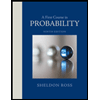
A First Course in Probability (10th Edition)
10th Edition
ISBN: 9780134753119
Author: Sheldon Ross
Publisher: PEARSON
expand_more
expand_more
format_list_bulleted
Concept explainers
Topic Video
Question
List all possible subsets
1. E = {1, 2, 3, 4}
2. D = {1, 2, 3}
3. C = {1, 2}
4. B = {1}
Expert Solution
This question has been solved!
Explore an expertly crafted, step-by-step solution for a thorough understanding of key concepts.
This is a popular solution
Trending nowThis is a popular solution!
Step by stepSolved in 2 steps with 1 images

Knowledge Booster
Learn more about
Need a deep-dive on the concept behind this application? Look no further. Learn more about this topic, probability and related others by exploring similar questions and additional content below.Similar questions
- Number of basketball teams (five players) that can be formed from eight players. Note that a basketball team has positions.arrow_forwardLet A = {1, 2, 3, 4, 5} and R = {(1, 1), (1, 3), (1, 5), (2, 2), (2, 4), (3, 1), (3, 3), (3, 5), (4, 2), (4, 4), (5, 1), (5, 3), (5, 5)}. Find the (3, 4) entry in (MR)5 by considering paths in R.arrow_forward(0,7),(1,5),(1.5,3),(2,5),(2.3,3.2),(3,2),(3.5,4)}{(0,7),(1,5),(1.5,3),(2,5),(2.3,3.2),(3,2),(3.5,4)} The regression line is: y= - ?arrow_forward
arrow_back_ios
arrow_forward_ios
Recommended textbooks for you
 A First Course in Probability (10th Edition)ProbabilityISBN:9780134753119Author:Sheldon RossPublisher:PEARSON
A First Course in Probability (10th Edition)ProbabilityISBN:9780134753119Author:Sheldon RossPublisher:PEARSON

A First Course in Probability (10th Edition)
Probability
ISBN:9780134753119
Author:Sheldon Ross
Publisher:PEARSON
